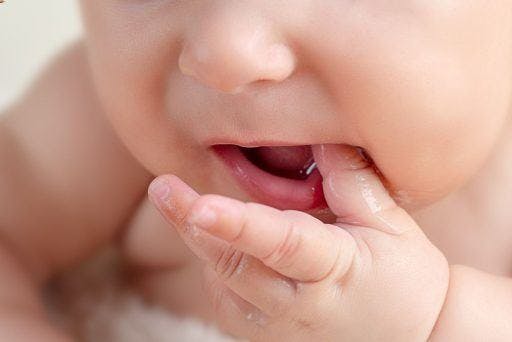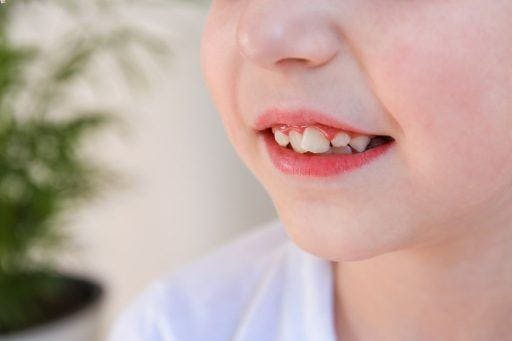Is your child getting their first set of teeth or being fussy for another reason? Thankfully, it’s easy to tell when your little one is at this developmental stage. Here are a few teething symptoms you can expect and what to do about them.
When does teething begin for infants?
Teething usually starts at the age of 6 to 12 months. However, the timing can vary – some babies might experience it earlier or later.
How to tell if your baby’s crying is from teething

Every child is different, so not all signs of teething will manifest. Some may not even show any baby teething symptoms at all. According to experts from the Australian Dental Association (ADA) and the American Academy of Paediatrics (AAP), these are some of the most common symptoms of teething in infants.
1. Sore or tender gums
Gums can swell because of baby teeth pushing through to the surface. This pressure can lead to inflammation and tenderness, which can cause some discomfort for your little one. You can expect them to become irritable.
Keep in mind, teething isn’t always behind crying and sleeplessness during this period. See your paediatrician for a checkup if you notice your baby is more unsettled than usual.
2. Drooling and mild rashes
Your baby’s body may respond to teething by producing more saliva to relieve tender gums. Babies also typically put their hands, toys, and other objects in their mouth to self-soothe, leading to even more drooling. The moisture and bacteria can trigger mild rashes when saliva gets on their mouth, chin, and neck.
Be sure to keep these areas clean and dry to avoid irritation.
3. Chewing and biting
Teething babies will want to nibble on everything for relief and stimulation. Instead of letting them go wild on their fists, fingers, and whatever they can reach, it’s safer to redirect their energy by giving them appropriate teething toys. Watch them closely and keep choking hazards at a distance.
4. Fussiness and irritability
It’s normal for infants to become extra cranky when teething symptoms start. Since they can’t speak, they express their frustration and discomfort by fussing and crying. You may also have trouble feeding them as they’ll resist added pressure to their gums.
Plenty of hugs and reassurance can help ease your child through the teething period.
5. Tooth buds
Tooth buds will feel like small, rounded bumps along your baby’s gums. Eventually, these buds will erupt into teeth. According to the AAP, the lower bottom teeth (lower central incisors) are usually the first to come up. Most children should have a full set of baby teeth by age three.
Some teething symptoms in infants include trouble sleeping, loss of appetite, and fever. Diarrhoea, ear-tugging, and severe rashes (especially when they don’t improve with home care) may also cause concern. If your baby exhibits these symptoms, you may want to bring them to the doctor to rule out other illnesses.
How to soothe your teething baby

The best thing a caregiver can do for a teething infant is to give them loads of comfort and attention. Keep them close and be generous with cuddles to ease their distress. Other soothing techniques include massaging their gums with a clean finger and giving them smooth, sturdy rubber toys or chilled (not frozen!) teething rings or damp washcloths to chew on.
The ADA, AAP, and the American Dental Association advise against using homoeopathic teething tablets, amber beads and necklaces, and numbing gels with belladonna or benzocaine. For safety, ask your doctor for guidance on the right products for your child.
Babies should go to their first dental appointment after their first tooth erupts and no later than their first birthday.
If teething hasn’t started by the time they’re 12 months old, you should still bring them to a dentist. These checkups are essential for monitoring your child’s dental development, detecting and treating early signs of tooth decay, and getting advice on caring for their oral health.
How to care for your baby’s teeth and gums
Start your child’s dental care as soon as your baby starts to show teething symptoms because there’s an immediate risk of tooth decay.
To prevent plaque or bacteria from building up on the gums and baby teeth, use a wet face cloth or fresh gauze pad to wipe your baby’s gums gently. Clean your baby’s teeth after each feeding.
Once your baby’s first tooth appears, you can start brushing it twice a day with a soft-bristled toothbrush with a small head. Only use water when brushing for the first year and a half, and make sure to reach all surfaces of your infant’s teeth.
You can add a pea-sized amount of toothpaste once your child is 18 months or older. Choose a low-fluoride variety, and try to teach your child not to swallow it.
Flossing can start as soon as your baby has two adjacent teeth. You can ask for a demonstration of proper flossing technique for your child on your next dental visit.
Setting a good diet for your child helps keep their teeth and gums healthy. In the first year of life, babies should only drink breast milk or infant formula. After this, milk and water are your best options. Keep solid food low in sugar and acid when introducing solid food into your child’s diet.
Finally, when your child starts learning to walk, they risk bumping into things. Keep toddlers under supervision to avoid accidents and injuries, including chipping or other damage to the teeth and gums.
What not to do: Teething treatments to avoid
Cold gels may temporarily ease teething symptoms, but the relief doesn’t last long once the gel is washed away and swallowed with saliva. But if you keep reapplying teething gel, your baby may swallow too much. The numbing effect might then transfer to the throat and increase your child’s risk of choking.
Because feeding your child sugary food and drinks increases their risk of tooth decay, avoid dipping your baby’s dummy or pacifier in anything sweet, like honey, jam, or juice.
You can also ditch beaded bracelets or necklaces, as there’s no guarantee these can help with pain. Worse, they can be choking hazards.
Should you be worried about crooked baby teeth?

The Australian Society of Orthodontists (ASO) confirms that children with crooked baby teeth will presumably need orthodontic treatment later in life.
Some causes of misalignment include habits that interfere with tooth movement, like thumb-sucking and prolonged pacifier use. Genetics also plays a significant role in how someone’s teeth develop. Children with a family history of crooked teeth are likelier to have the same issue.
The ASO recommends that children see a registered specialist orthodontist for an assessment between the ages of 8 to 10. These dental care providers can evaluate your child’s existing teeth and spot potential issues early. If crookedness is a concern, ask them about preventive measures and long-term treatment plans.
Traditional braces are the most common fix for misaligned teeth among adolescents. But invisible aligners, like ClearCorrect, are rapidly gaining favour among those seeking a more discreet and comfortable solution. Discuss options with your child’s treating dentist. It’s never too early to start thinking about orthodontics!
Has your little one been showing teething symptoms? Congratulations – their first teeth are coming in! Use this as a general guide for navigating this exciting stage of your baby’s development. And don’t forget to consult your dentist for expert advice!
References:
American Academy of Pediatrics. (n.d.). Baby’s first tooth: 7 facts Parents should know. healthychildren.org.
American Dental Association. (n.d.). Teething. mouthhealthy.org.
Australian Dental Association. (n.d.-b). Baby and toddler oral health. teeth.org.au.
Department of Health and Aged Care, Australian Government. (n.d.). Baby teeth. pregnancybirthbaby.org.au.
Department of Health and Aged Care, Australian Government. (n.d.). Dental care for babies and children. pregnancybirthbaby.org.au.
Orthodontics Australia. Does it matter if my child has crooked baby teeth?. orthodonticsaustralia.org.au.
Orthodontics Australia. (2023b). Benefits of early treatment. orthodonticsaustralia.org.au.
Seattle Children’s Hospital. (n.d.). Teething. seattlechildrens.org.
Stanford Medicine Children’s Health. (n.d.-b). Teething. stanfordchildrens.org.



